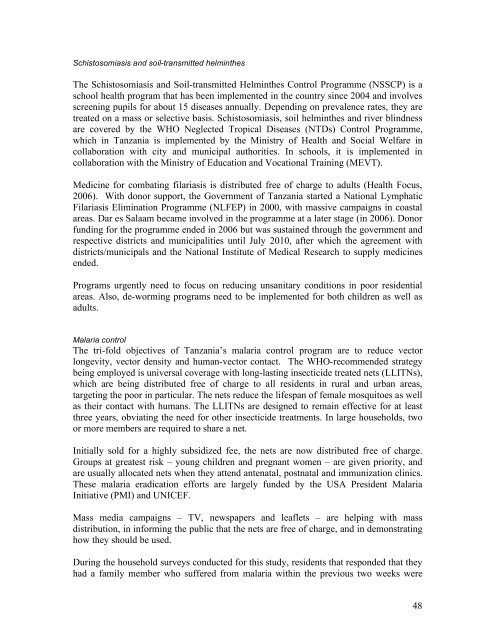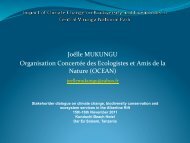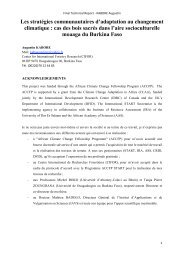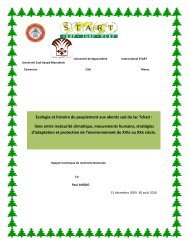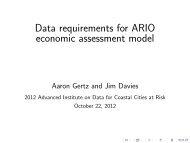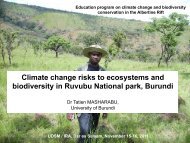Urban Poverty & Climate Change in Dar es Salaam, Tanzania:
Urban Poverty & Climate Change in Dar es Salaam, Tanzania:
Urban Poverty & Climate Change in Dar es Salaam, Tanzania:
You also want an ePaper? Increase the reach of your titles
YUMPU automatically turns print PDFs into web optimized ePapers that Google loves.
Schistosomiasis and soil-transmitted helm<strong>in</strong>th<strong>es</strong><br />
The Schistosomiasis and Soil-transmitted Helm<strong>in</strong>th<strong>es</strong> Control Programme (NSSCP) is a<br />
school health program that has been implemented <strong>in</strong> the country s<strong>in</strong>ce 2004 and <strong>in</strong>volv<strong>es</strong><br />
screen<strong>in</strong>g pupils for about 15 diseas<strong>es</strong> annually. Depend<strong>in</strong>g on prevalence rat<strong>es</strong>, they are<br />
treated on a mass or selective basis. Schistosomiasis, soil helm<strong>in</strong>th<strong>es</strong> and river bl<strong>in</strong>dn<strong>es</strong>s<br />
are covered by the WHO Neglected Tropical Diseas<strong>es</strong> (NTDs) Control Programme,<br />
which <strong>in</strong> <strong>Tanzania</strong> is implemented by the M<strong>in</strong>istry of Health and Social Welfare <strong>in</strong><br />
collaboration with city and municipal authoriti<strong>es</strong>. In schools, it is implemented <strong>in</strong><br />
collaboration with the M<strong>in</strong>istry of Education and Vocational Tra<strong>in</strong><strong>in</strong>g (MEVT).<br />
Medic<strong>in</strong>e for combat<strong>in</strong>g filariasis is distributed free of charge to adults (Health Focus,<br />
2006). With donor support, the Government of <strong>Tanzania</strong> started a National Lymphatic<br />
Filariasis Elim<strong>in</strong>ation Programme (NLFEP) <strong>in</strong> 2000, with massive campaigns <strong>in</strong> coastal<br />
areas. <strong>Dar</strong> <strong>es</strong> <strong>Salaam</strong> became <strong>in</strong>volved <strong>in</strong> the programme at a later stage (<strong>in</strong> 2006). Donor<br />
fund<strong>in</strong>g for the programme ended <strong>in</strong> 2006 but was susta<strong>in</strong>ed through the government and<br />
r<strong>es</strong>pective districts and municipaliti<strong>es</strong> until July 2010, after which the agreement with<br />
districts/municipals and the National Institute of Medical R<strong>es</strong>earch to supply medic<strong>in</strong><strong>es</strong><br />
ended.<br />
Programs urgently need to focus on reduc<strong>in</strong>g unsanitary conditions <strong>in</strong> poor r<strong>es</strong>idential<br />
areas. Also, de-worm<strong>in</strong>g programs need to be implemented for both children as well as<br />
adults.<br />
Malaria control<br />
The tri-fold objectiv<strong>es</strong> of <strong>Tanzania</strong>’s malaria control program are to reduce vector<br />
longevity, vector density and human-vector contact. The WHO-recommended strategy<br />
be<strong>in</strong>g employed is universal coverage with long-last<strong>in</strong>g <strong>in</strong>secticide treated nets (LLITNs),<br />
which are be<strong>in</strong>g distributed free of charge to all r<strong>es</strong>idents <strong>in</strong> rural and urban areas,<br />
target<strong>in</strong>g the poor <strong>in</strong> particular. The nets reduce the lif<strong>es</strong>pan of female mosquito<strong>es</strong> as well<br />
as their contact with humans. The LLITNs are d<strong>es</strong>igned to rema<strong>in</strong> effective for at least<br />
three years, obviat<strong>in</strong>g the need for other <strong>in</strong>secticide treatments. In large households, two<br />
or more members are required to share a net.<br />
Initially sold for a highly subsidized fee, the nets are now distributed free of charge.<br />
Groups at great<strong>es</strong>t risk – young children and pregnant women – are given priority, and<br />
are usually allocated nets when they attend antenatal, postnatal and immunization cl<strong>in</strong>ics.<br />
Th<strong>es</strong>e malaria eradication efforts are largely funded by the USA Pr<strong>es</strong>ident Malaria<br />
Initiative (PMI) and UNICEF.<br />
Mass media campaigns – TV, newspapers and leaflets – are help<strong>in</strong>g with mass<br />
distribution, <strong>in</strong> <strong>in</strong>form<strong>in</strong>g the public that the nets are free of charge, and <strong>in</strong> demonstrat<strong>in</strong>g<br />
how they should be used.<br />
Dur<strong>in</strong>g the household surveys conducted for this study, r<strong>es</strong>idents that r<strong>es</strong>ponded that they<br />
had a family member who suffered from malaria with<strong>in</strong> the previous two weeks were<br />
48


